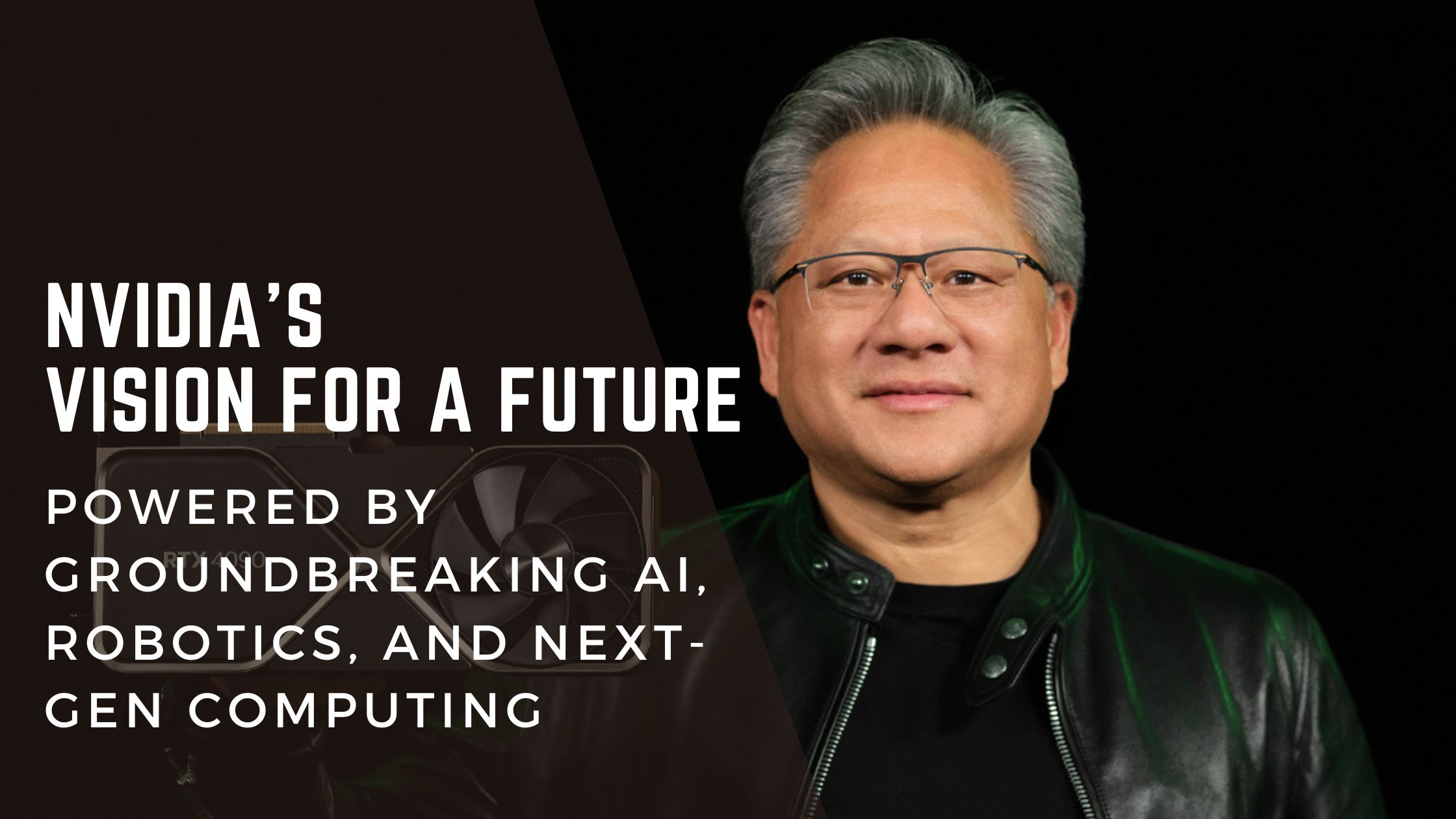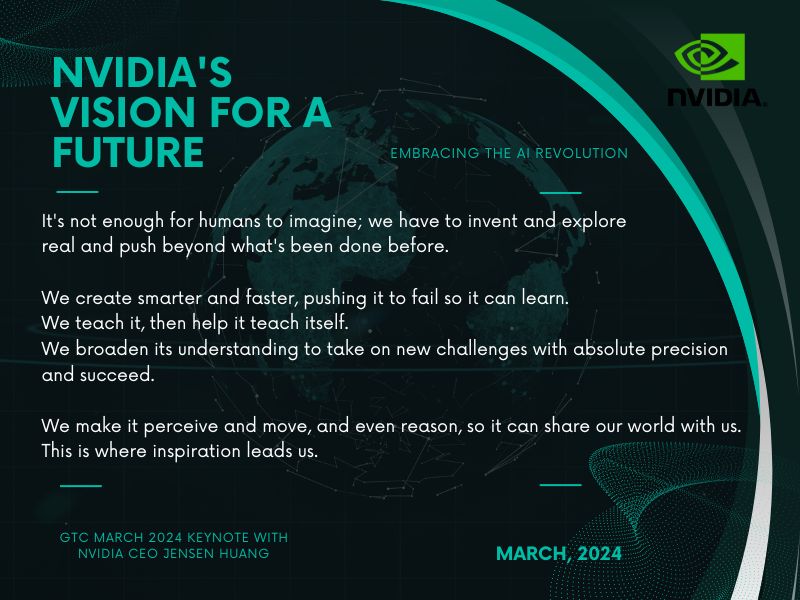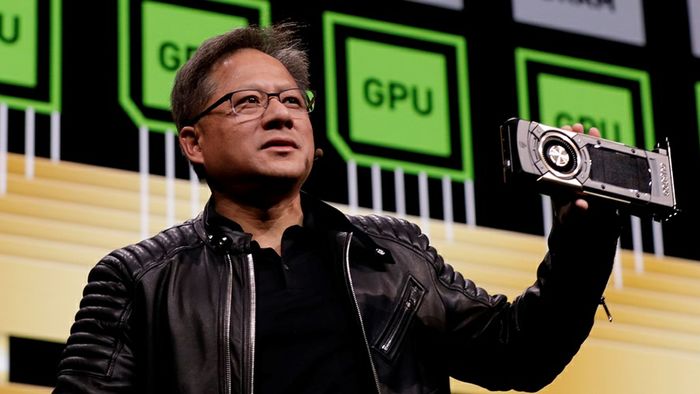Embracing the AI Revolution: NVIDIA’s Vision for a Future Powered by Groundbreaking AI
With each wave of new technology, there’s a mix of excitement and unease.
It’s like standing at the ocean’s edge as a big wave comes in. You’re not quite sure whether to jump in or run away.
Some folks are worried about keeping up, scared that robots might take their jobs. Others see people already making a fortune with these new AI tools and feel like they’re falling behind.
It’s a lot to take in, and for many, it’s overwhelming trying to figure out how to fit these advancements into their everyday lives.
I can assure you that I’ve already experienced many of these emotions.
But here’s the thing: amidst all this change, a world of opportunity awaits us. NVIDIA’s recent showcase in March 2024 is a bright beacon, showing us how these tech marvels can make our lives better, not more complicated.
Empowering Creativity with AI
Imagine having AI that can help you create beautiful art or write code, making tasks quicker and sparking more creativity. It’s about giving us the tools to do more of what we love without the extra hassle.
And those robots we’re worried about? They’re here to lend a hand, not take over. They’re designed to work alongside us, taking care of the heavy lifting or repetitive tasks, freeing us up to focus on our work’s creative and meaningful parts.
NVIDIA’s AI factories and digital twins are like a grand show’s backstage crew, ensuring everything runs smoothly. They keep the creative AI and helpful robots going strong, ensuring that we can rely on these tools whenever needed.
The best part is that NVIDIA is making it easier for all of us to join in, no matter what we do. They’re building tools that feel more like helpers than high-tech mysteries, designed to fit right into our lives and work.
Embracing the New Tech Wave
So, if you’re feeling a bit adrift in this sea of new tech, remember, it’s here to help us ride the waves, not drown in them. It’s about using these innovations to enhance our lives, making our work more enjoyable, and opening up new possibilities we’ve only dreamed of.
The GTC (GPU Technology Conference) March 2024 Keynote by NVIDIA CEO Jensen Huang introduced several advancements in AI and how they shape various industries, providing key takeaways for how ordinary people can prepare for and utilize these advancements.
NVIDIA’s Vision for a Future and How Ordinary People Can Prepare for and Utilize These Advancements
Advancements in Generative AI
NVIDIA announced advancements in generative AI models, which can now create content such as images, videos, and even software code. This technology can potentially revolutionize creative industries, software development, and content creation.
✅Preparation and Use: Individuals working in creative fields should familiarize themselves with AI tools to augment their creative process. Learning to interact with and direct AI platforms for content generation can open up new career opportunities and means of production.
Robotic Systems and Automation
The keynote touched on integrating AI into robotics, highlighting the vision of autonomous systems seamlessly working in industrial settings. These include warehouse operations, automobile manufacturing, and even humanoid robots for everyday tasks.
✅Preparation and Use: Workers in manufacturing and logistics should stay informed about how their jobs might evolve with the introduction of robotic co-workers. Gaining skills in robot programming, AI system monitoring, and collaborative robotics could be valuable.
AI Factories and AI-Driven Computing Infrastructure
The concept of AI factories suggests a shift toward dedicated computing infrastructure to run and maintain generative AI applications.
✅Preparation and Use: IT professionals and data center technicians should seek knowledge about the infrastructure requirements of AI systems. Skill development in AI maintenance, optimization, and cloud services could be crucial for future job security.
Digital Twins
Omniverse and digital twin technology have been emphasized for accurate simulation of real-world environments, processes, and objects in the digital realm.
✅Preparation and Use: Engineers, architects, and professionals in construction and product design can leverage digital twin technology to iterate designs, run simulations, and improve project outcomes. Learning software that integrates with digital twin platforms can be beneficial.
NVIDIA’s New Systems and Services
New systems like Project Blackwell, a giant processor designed for AI workloads, and new services like Nemo Retriever and AI microservices (Nims), let users interact with AI models and data in new ways.
✅Preparation and Use: Businesses should consider incorporating these AI services into their operations to streamline processes, enhance decision-making, and engage with customers. Developers and entrepreneurs should look into how they might develop new services or applications atop NVIDIA’s platforms.
Collaborative Tools for AI Development
Collaboration between significant industry players and NVIDIA’s AI Foundry allows for the development of specialized AI co-pilots for different fields like healthcare, commerce, and IT management.
✅Preparation and Use: Professionals should seek partnerships and training offerings by NVIDIA or its allies to develop domain-specific AI applications, enhancing their expertise and services.
Education and Training
As AI and robotics become more integrated into various sectors, education and continuous learning will be critical for everyone. Individuals can prepare by taking online courses, attending workshops, and staying updated on AI and robotics trends.
General Advice
For ordinary people, staying informed and continually learning about these technologies is crucial. Engaging with community programs, online courses (e.g., Coursera, Udemy, Khan Academy), and other educational resources can help build understanding and skills relevant to an AI-powered future.
Lastly, embracing a mindset of flexibility and adaptability will be essential as these technologies lead to changes in the job market and society. Those willing to learn and adapt will be best positioned to succeed in an increasingly AI-integrated world.
It’s not enough for humans to imagine; we must invent and explore reality and push beyond what’s been done before. We create smarter and faster, we push it to fail so it can learn. We teach it, then help it teach itself.
We broaden our understanding to take on new challenges precisely and succeed. We make it perceive and move, and even reason, so it can share our world with us. This is where inspiration leads us. The next frontier. This is Nvidia Project Groot, a general-purpose foundation model for humanoid robot learning.
How is NVIDIA so successful?
NVIDIA’s success can be attributed to several key factors that have positioned it as a leader in the tech industry:
- Innovation and R&D: NVIDIA has consistently invested heavily in research and development, driving breakthroughs in GPU technology, AI, and deep learning. Their commitment to innovation has led to the creation of cutting-edge products that meet the evolving needs of various industries.
- Diversification: Originally focused on graphics processing units (GPUs) for gaming, NVIDIA has successfully diversified its product lineup to cater to a broad range of applications, including automotive, data centers, professional visualization, and artificial intelligence. This diversification has opened up multiple revenue streams and reduced reliance on any single market.
- Strategic Partnerships: NVIDIA has formed strategic alliances with leading companies across different sectors, including automotive, healthcare, and entertainment. These partnerships have expanded its market reach and fortified its presence in key industries.
- AI and Deep Learning: NVIDIA has positioned itself at the forefront of AI and deep learning technology, with its GPUs being the hardware of choice for training complex neural networks. This foresight has placed NVIDIA at the center of the AI revolution, powering some of the most advanced AI applications and systems.
- Strong Ecosystem: NVIDIA has built a robust ecosystem around its products, including software development kits (SDKs), tools like CUDA for parallel computing, and platforms like NVIDIA DGX systems for AI research. This ecosystem not only enhances the utility and appeal of NVIDIA products but also fosters innovation among developers and researchers.
- Brand Reputation and Loyalty: NVIDIA has cultivated a strong brand that is known for quality and performance. Its GPUs are highly regarded among gamers, professionals, and researchers, leading to a loyal customer base that continues to grow as NVIDIA expands into new markets.
- Agility and Adaptability: NVIDIA has demonstrated an ability to adapt to market changes and emerging trends quickly. This agility has allowed NVIDIA to stay ahead of competitors and continuously offer relevant, high-demand products and solutions.
By combining technological leadership with strategic diversification and a strong focus on future-oriented markets like AI, NVIDIA has secured its position as a pivotal player in the global tech landscape, driving its continued success and growth.






















